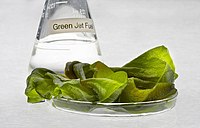
Photo from wikipedia
The cultivation of microalgae requires the selection of optimal parameters. In this work, the effect of various forms of nitrogen on the growth and productivity of Chlorella sorokiniana AM-02 when… Click to show full abstract
The cultivation of microalgae requires the selection of optimal parameters. In this work, the effect of various forms of nitrogen on the growth and productivity of Chlorella sorokiniana AM-02 when cultivated at different temperatures was evaluated. Regardless of the temperature conditions, the highest specific growth rate of 1.26 day−1 was observed in modified Bold’s basal medium (BBM) with NH4+ as a nitrogen source, while the highest specific growth rate in BBM with NO3− as a nitrogen source achieved only 1.07 day−1. Moreover, C. sorokiniana grew well in medium based on anaerobic digester effluent (ADE; after anaerobic digestion of chicken/cow manure) with the highest growth rate being 0.92 day−1. The accumulation of proteins in algal cells was comparable in all experiments and reached a maximum of 42% of dry weight. The biomass productivity reached 0.41–0.50 g L−1 day−1 when cultivated in BBM, whereas biomass productivity of 0.32–0.35 g L−1 day−1 was obtained in ADE-based medium. The results, based on a bacterial 16S rRNA gene sequencing approach, revealed the growth of various bacterial species in ADE-based medium in the presence of algal cells (their abundance varied depending on the temperature regimen). The results indicate that biomass from C. sorokiniana AM-02 may be sustainable for animal feed production considering the high protein yields.
Journal Title: Plants
Year Published: 2022
Link to full text (if available)
Share on Social Media: Sign Up to like & get
recommendations!